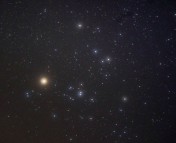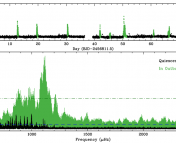Title: Very regular high-frequency pulsation modes in young intermediate-mass stars
Authors: T. R. Bedding, S. J. Murphy, D. R. Hey, D. Huber, T. Li, B. Smalley, D. Stello, T. R. White, W. H. Ball, W. J. Chaplin, I. L. Colman, J. Fuller, E. Gaidos, D. R. Harbeck, J. J. Hermes, D. L. Holdsworth, G. Li, Y. Li, A. W. Mann, D. R. Reese, S. Sekaran, J. Yu, V. Antoci, C. Bergmann, T. M. Brown, A. W. Howard, M. J. Ireland, H. Isaacson, J. M. Jenkins, H. Kjeldsen, C. McCully, M. Rabus, A. D. Rains, G. R. Ricker, C. G. Tinney and R. K. Vanderspek
First author’s institute: Sydney Institute for Astronomy (SIfA), School of Physics, University of Sydney, Camperdown, New South Wales, Australia
Status: Published in Nature
Disclaimer: The author of this Astrobite works in the same research department as some of the coauthors on this paper, but was not involved in the presented work.
As stars evolve on to the main sequence, they start to burn hydrogen in their cores, producing energy. As energy is carried outwards, the heat transport can cause stars to expand and contract, causing their brightness to vary. The study of this stellar variability is called asteroseismology, and tells us about what is going on inside stars, using what we observe happening on their surface.
Stars of different masses and evolutionary stages oscillate in different ways. One class of variable stars are so-called delta Scuti (δ Scuti) stars. These include main sequence stars of masses between roughly 1.5 and 2.5 times the mass of the Sun. Observations of δ Scuti stars have allowed astronomers to construct a relationship between the period of their strongest oscillation and their luminosity, allowing them to calculate distances to these stars.
However, to really understand oscillating stars, it is important to move beyond period-luminosity relations, by characterising individual oscillation frequencies. This is commonly done for stars that oscillate in the same way as our Sun (solar-like oscillators), which exhibit oscillations at evenly spaced frequencies. If stars display oscillations of evenly spaced frequencies, then asteroseismology can be used to study a wider range of their fundamental properties. However for δ Scuti stars observed by the Kepler mission, no such clear pattern appeared. Instead, their modes of oscillation seemed to be distributed near-randomly. This has made it impossible for astronomers to probe δ Scuti stars in more detail, and find out properties such as their age.
New Mission, New Data
Today’s authors set out to change the study of δ Scuti stars by finding a regular pattern in the oscillations of these stars. Such stars with regular spacings had been found before, but in limited numbers. In order to determine a consistent pattern of oscillations in δ Scuti stars, they would need a much larger sample of stars to study. The solution to finding this pattern was through the new TESS mission. With its all-sky focus, TESS observed hundreds of thousands of stars in 27-day intervals, unlike the Kepler mission, which only focused on one patch of the sky.
To find these regular patterns, today’s authors built a pipeline to study thousands of potential δ Scuti stars observed by Kepler and TESS, singling out those that showed pulsations at high frequencies (30 or more pulsation cycles per day). The focus on the high-frequency regime is because the regular spacing of modes is disrupted at low-frequencies, a property common of multiple types of variable star. From their entire sample, they identified 60 stars with regularly spaced modes of oscillation. The pulsation spectrum of a sample of these is shown in Figure 1, showing the repeating structure.
Stars such as δ Scuti’s oscillate in many frequencies at the same time (imagine the sound of someone falling asleep on a piano). This creates a rich spectrum of modes of oscillation in a pulsation spectrum of the star. By looking at échelle diagrams of these stars (Figure 2), they were able to precisely determine the regular spacing of the modes of oscillation, Δν . Because different oscillations travel through different parts of the star, Δν carries information about how the sound speed changes inside the star, which is linked to the average stellar density.
What’s changed?
This large sample of δ Scuti stars with oscillations evenly spaced in frequency represents only a small fraction of the total number of stars studied. What makes these stars special? The authors consider two potential reasons.
First, comparing their sample of stars to evolutionary tracks (see Figure 3), they find that the stars with regular spacings are still early in their main sequence lifetimes. The young ages of these stars might be the reason— as oscillating stars evolve, their modes of oscillations propagating near the surface will begin to interact with those propagating in the stellar core, disrupting their oscillation frequencies. In other words, this sample of δ Scutis with evenly-spaced oscillation frequencies may just be younger than those observed by Kepler.
Second, they hypothesise that this might be due to how the stars in their sample are oriented in space. δ Scuti stars typically rotate very fast (around 2 days, as opposed to 24 days for our Sun). In oscillating stars, fast rotation can split modes of oscillation, and disrupt the evenly spaced pattern. However this effect only shows up in our observations if we can perceive the star as rotating. If we view it pole-on, the effects of rotation are invisible to us.
To check this, today’s authors used the HIRES and NRES spectrographs to measure the projected rotational velocity (defined as v sin(i), where v is velocity and i is inclination angle of the equator of the star with respect to us) of the 60 stars with regular spacings. They found that their sample included many stars with low v sin(i). This implies that their inclination angles are very low (i.e. viewed pole on). Perhaps the only reason regular spacing is observed in this sample is because the effects of the δ Scuti’s fast rotation are not observed.
New Science with δ Scutis
Using their new understanding of the regular spacing of oscillations in these stars, today’s authors were able to identify the exact overtones each oscillation belonged to. This opens up detailed comparisons to stellar models of these frequencies, which was previously not possible for δ Scuti stars.
One of the examples they show of new science possible with δ Scutis is a determination of the age of the star HD 31901, a member of a distinct stream of stars orbiting the Milky Way. Using stellar models and their newly measured oscillation frequencies they find an age of 150 ± 100 million years. This was in agreement with gyrochronology estimates of this stellar population, and so this new analysis of a δ Scuti star has helped constrain the age of these stars.
This new revolution in how we understand δ Scuti stars is only just beginning with this study. As TESS moves into its extended mission in July 2020, it is expected to detect a much larger number of δ Scuti stars with regularly spaced patterns, extending the reach of asteroseismology further than ever before.




